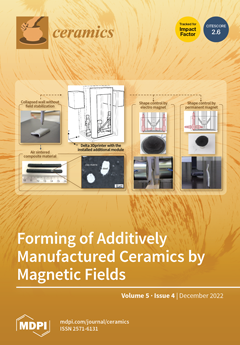Here, we report on the opportunity to suppress Yb
3+ to Yb
2+ dopant-ion reduction in LiYb
xY
1−xF
4 mixed crystals during growth processes, using the Bridgmen–Stocbarger technique in graphite crucibles in vacuum. This was carried out by the additional
[...] Read more.
Here, we report on the opportunity to suppress Yb
3+ to Yb
2+ dopant-ion reduction in LiYb
xY
1−xF
4 mixed crystals during growth processes, using the Bridgmen–Stocbarger technique in graphite crucibles in vacuum. This was carried out by the additional doping of the LiF-YF
3-YbF
3 powder mixture with 1% of BiF
3 additive. The crystals of LiY
0.8Yb
0.2F
4 and LiY
0.8Yb
0.2F
4 with BiF
3 doping in the charge, were grown. The spatial distribution of the spectral-kinetic properties of Yb
3+ and Yb
2+ ions along the grown crystalline-boules were studied. It was established that the Yb
2+ concentration rises during the LiY
0.8Yb
0.2F
4 crystal-growth processes without the BiF
3 additive: the absorption coefficient of Yb
2+ (π-polarization) at 340 nm rises from 0 (at the beginning of the boule) to 2.5 cm
−1 (at the end of the boule). In contrast, the undetectable absorption of Yb
2+ along the crystals grown from the BiF
3 doped melt was displayed. The luminescence-decay time of Yb
3+ decreases from 3.7 to 1.8 ms from the beginning to the end of the LiY
0.8Yb
0.2F
4 boule grown from the BiF
3 undoped melt, and stays constant (~3.7 ms) along the samples grown with BiF
3. Here we demonstrate a positive effect of BiF
3 doping on the optical homogeneity of LiYF
4:Yb
3+ crystals.
Full article





